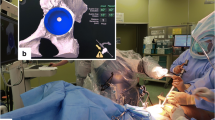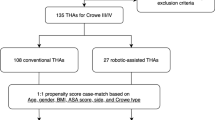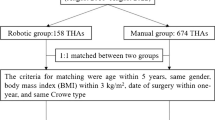Abstract
Background
The clinical effectiveness of robotic arm-assisted systems remains unclear for total hip arthroplasty (THA) in patients suffering from osteoarthritis secondary to developmental dysplasia of the hip (DDH).
Methods
Patients with DDH who underwent primary THA were included in this study. We conducted a propensity score-matched comparison between THAs using a robotic arm-assisted system (Mako group) versus those using the manual procedure (manual group) to compare the absolute differences in cup placement angles measured using postoperative computed tomography and those planned preoperatively.
Results
A total of 217 patients with osteoarthritis due to DDH met the inclusion criteria. Eighty-four patients were matched as the Mako group and 84 as the manual group. The differences were smaller in the Mako group than the manual group in terms of both inclination and anteversion angles (1.1 ± 1.0 versus 4.2 ± 3.1, respectively; 95% CI, 2.4 to 3.8; p < 0.0001, and 1.2 ± 1.1 versus 5.8 ± 4.0, respectively; 95% CI, 3.7 to 5.5; p < 0.0001).
Conclusions
The robotic arm-assisted system may provide more accurate cup placement in THA for DDH.



Similar content being viewed by others
References
Ferguson RJ, Palmer AJ, Taylor A, Porter ML, Malchau H, Glyn-Jones S (2018) Hip replacement. Lancet 392:1662–1671. https://doi.org/10.1016/S0140-6736(18)31777-X
Wasterlain AS, Buza JA 3rd, Thakkar SC, Schwarzkopf R, Vigdorchik J (2017) Navigation and robotics in total hip arthroplasty. JBJS Rev 5:e2. https://doi.org/10.2106/JBJS.RVW.16.00046
Parvizi J, Picinic E, Sharkey PF (2008) Revision total hip arthroplasty for instability: surgical techniques and principles. J Bone Joint Surg Am 90:1134–1142
Domb BG, El Bitar YF, Sadik AY, Stake CE, Botser IB (2014) Comparison of robotic-assisted and conventional acetabular cup placement in THA: a matched-pair controlled study. Clin Orthop Relat Res 472:329–336. https://doi.org/10.1007/s11999-013-3253-7
Rogers BA, Garbedian S, Kuchinad RA, Backstein D, Safir O, Gross AE (2012) Total hip arthroplasty for adult hip dysplasia. J Bone Joint Surg Am 3(94):1809–1821. https://doi.org/10.2106/JBJS.K.00779
Stans AA, Pagnano MW, Shaughnessy WJ, Hanssen AD (1998) Results of total hip arthroplasty for Crowe type III developmental hip dysplasia. Clin Orthop Relat Res 348:149–157. https://doi.org/10.1097/00003086-199803000-00024
Crowe JF, Mani VJ, Ranawat CS (1979) Total hip replacement in congenital dislocation and dysplasia of the hip. J Bone Joint Surg Am 61:15–23. https://doi.org/10.2106/00004623-197961010-00004
Dastane M, Dorr LD, Tarwala R, Wan Z (2011) Hip offset in total hip arthroplasty: quantitative measurement with navigation. Clin Orthop Relat Res 469:429–436. https://doi.org/10.1007/s11999-010-1554-7
Nawabi DH, Conditt MA, Ranawat AS, Dunbar NJ, Jones J, Banks S et al (2013) Haptically guided robotic technology in total hip arthroplasty: a cadaveric investigation. Proc Inst Mech Eng H 227:302–309. https://doi.org/10.1177/0954411912468540
Sugano N, Nishii T, Nakata K, Masuhara K, Takaoka K (1995) Polyethylene sockets and alumina ceramic heads in cemented total hip arthroplasty. A ten-year study. J Bone Joint Surg Br 77:548–556. https://doi.org/10.1302/0301-620X.77B4.7615596 (Erratum in: J Bone Joint Surg Br. 77:985)
Bricteux S, Beguin L, Fessy MH (2001) Iliopsoas impingement in 12 patients with a total hip arthroplasty. Rev Chir Orthop Reparatrice Appar Mot 87:820–825
Murray DW (1993) The definition and measurement of acetabular orientation. J Bone Joint Surg Br 75:228–232. https://doi.org/10.1302/0301-620X.75B2.8444942
Tatsugami F, Higaki T, Sakane H, Fukumoto W, Iida M, Baba Y et al (2016) Coronary CT angiography in patients with implanted cardiac devices: initial experience with the metal artefact reduction technique. Br J Radiol 89:20160493. https://doi.org/10.1259/bjr.20160493
Tokunaga K, Okamoto M, Watanabe K (2018) Implant orientation measurement after THA using the EOS X-ray image acquisition system. Adv Exp Med Biol 1093:335–343. https://doi.org/10.1007/978-981-13-1396-7_26
Imai N, Takubo R, Suzuki H, Shimada H, Miyasaka D, Tsuchiya K et al (2019) Accuracy of acetabular cup placement using CT-based navigation in total hip arthroplasty: comparison between obese and non-obese patients. J Orthop Sci 24:482–487. https://doi.org/10.1016/j.jos.2018.11.007
D’Aubigne RM, Postel M (1954) Functional results of hip arthroplasty with acrylic prosthesis. J Bone Joint Surg Am 36 A:451–475
Matta JM, Mehne DK, Roffi R (1986) Fractures of the acetabulum. Early results of a prospective study. Clin Orthop Relat Res 205:241–250
Kanda Y (2013) Investigation of the freely available easy-to-use software “EZR” for medical statistics. Bone Marrow Transplant 48:452–458. https://doi.org/10.1038/bmt.2012.244
Hayashi S, Hashimoto S, Kuroda Y, Nakano N, Matsumoto T, Ishida K et al (2021) Robotic-arm assisted THA can achieve precise cup positioning in developmental dysplasia of the hip: a case control study. Bone Joint Res 10:629–638. https://doi.org/10.1302/2046-3758.1010.BJR-2021-0095.R1
Tsutsui T, Goto T, Wada K, Takasago T, Hamada D, Sairyo K (2017) Efficacy of a computed tomography-based navigation system for placement of the acetabular component in total hip arthroplasty for developmental dysplasia of the hip. J Orthop Surg (Hong Kong) 25:2309499017727954. https://doi.org/10.1177/2309499017727954
Ando W, Takao M, Hamada H, Uemura K, Sugano N (2021) Comparison of the accuracy of the cup position and orientation in total hip arthroplasty for osteoarthritis secondary to developmental dysplasia of the hip between the Mako robotic arm-assisted system and computed tomography-based navigation. Int Orthop 45:1719–1725. https://doi.org/10.1007/s00264-021-05015-3
Ng N, Gaston P, Simpson PM, Macpherson GJ, Patton JT, Clement ND (2021) Robotic arm-assisted versus manual total hip arthroplasty : a systematic review and meta-analysis. Bone Joint J 103:1009–1020. https://doi.org/10.1302/0301-620X.103B6
Redmond JM, Gupta A, Hammarstedt JE, Petrakos AE, Finch NA, Domb BG (2015) The learning curve associated with robotic-assisted total hip arthroplasty. J Arthroplasty 30:50–54. https://doi.org/10.1016/j.arth.2014.08.003
Kayani B, Konan S, Huq SS, Ibrahim MS, Ayuob A, Haddad FS (2021) The learning curve of robotic-arm assisted acetabular cup positioning during total hip arthroplasty. Hip Int 31:311–319. https://doi.org/10.1177/1120700019889334
Acknowledgements
The authors thank Sachiyuki Tsukada MD, PhD, Masanori Kase MD, Akimasa Kimura MD, Naoyuki Hirasawa MD, PhD, Hiroyuki Ogawa MD, and Keisuke Nogi MD.
Funding
The authors declare that no funds, grants, or other support were received during the preparation of this manuscript.
Author information
Authors and Affiliations
Corresponding author
Ethics declarations
Conflict of interest
Financial interests: Author Kei Sato, Atsuko Sato, Naoki Okuda, Hideyuki Koga declare they have no financial interests. Author Matsubara Masaaki has received speaker and consultant honoraria from Company Stryker Japan, Depuy-Synthes Japan Johnson and Johnson, Zimmer-Biomet Japan, Smith and Nephew Japan.
Ethical approval
This study was approved by the Ethical Review Committee of Nissan Tamagawa Hospital (Tama2021-032).
Additional information
Publisher's Note
Springer Nature remains neutral with regard to jurisdictional claims in published maps and institutional affiliations.
Rights and permissions
About this article
Cite this article
Sato, K., Sato, A., Okuda, N. et al. A propensity score-matched comparison between Mako robotic arm-assisted system and conventional technique in total hip arthroplasty for patients with osteoarthritis secondary to developmental dysplasia of the hip. Arch Orthop Trauma Surg 143, 2755–2761 (2023). https://doi.org/10.1007/s00402-022-04524-z
Received:
Accepted:
Published:
Issue Date:
DOI: https://doi.org/10.1007/s00402-022-04524-z




